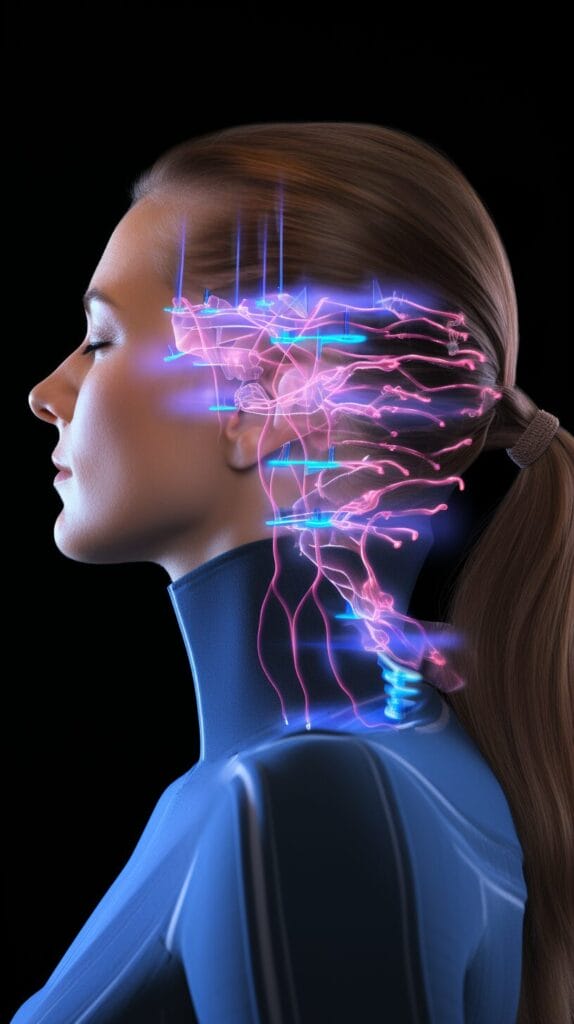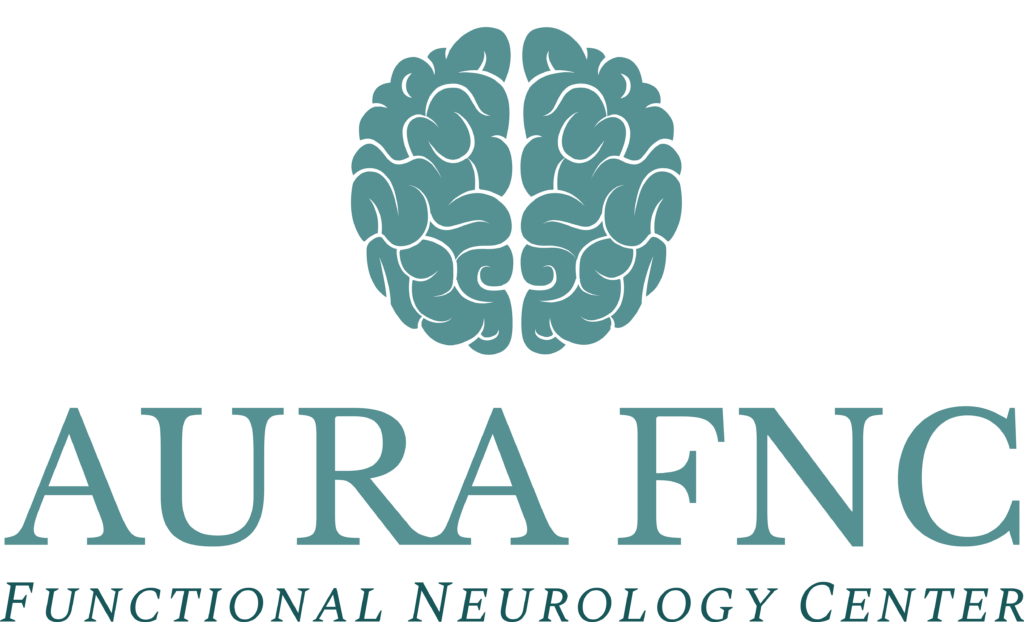Neuromodulation
What is Neuromodulation?
Neuromodulation is a medical procedure that involves the targeted application of electrical, chemical, or mechanical stimuli to specific areas of the nervous system to modulate its function. This can be achieved through the use of various devices, such as spinal cord stimulators, deep brain stimulators, and peripheral nerve stimulators, and is one of the modalities we use for treatment of neurological disorders at Aura Functional Neurology Center (Aura FNC).
Neuromodulation has been used to treat a wide range of neurological and psychiatric disorders, including chronic pain, Parkinson’s disease, epilepsy, depression, and obsessive-compulsive disorder. It has also shown promise in the treatment of conditions such as urinary incontinence, migraine headaches, and even obesity.
The goal of neuromodulation is to restore the normal functioning of the nervous system by altering the nerve activity in a targeted manner. This can be achieved through the delivery of electrical impulses to the affected area, the release of specific chemicals, or the use of devices that provide mechanical stimulation.

Dr. Diana Tyler DC, DACNB
Founder of Aura FNC with experience using neuromodulation with her patients at the Aura FNC office located in Cumming, Georgia right outside the Atlanta area. Doctor of Chiropractic and Functional Neurologist. Graduate of Palmer College of Chiropractic and a Diplomate of the American Chiropractic Neurology Board.

Neuromodulation is often considered when other treatments, such as medication or surgery, have failed to provide adequate relief. It is typically performed by a team of specialized medical professionals, including functional neurologists, neurosurgeons, neurologists, and pain management specialists.
In recent years, there has been significant advancement in the field of neuromodulation, leading to the development of more sophisticated devices and techniques. This has made the procedure safer, more effective, and more widely available to patients. These include home-based therapies used for long-term management of neurological conditions such as migraine.
Overall, neuromodulation offers a promising alternative for the treatment of various neurological conditions, and it continues to be an area of active research and development. As our understanding of the brain and nervous system continues to grow, neuromodulation will likely play an increasingly important role in the management of these complex disorders.
Importance of neuromodulation in treating various conditions
Neuromodulation has become an increasingly important tool in treating a wide range of medical conditions, offering new hope to patients who have not found success with traditional treatments. This innovative approach involves the use of targeted electrical or chemical stimulation to specific areas of the nervous system, with the goal of restoring normal function and alleviating symptoms.
One of the key advantages of neuromodulation is its ability to provide relief for conditions that have been resistant to other forms of treatment. Chronic pain, for example, can be incredibly debilitating for those who suffer from it, and many individuals find that traditional pain management techniques are ineffective or come with unwanted side effects. Neuromodulation offers a promising alternative, with a range of techniques such as spinal cord stimulation and peripheral nerve stimulation that can provide long-lasting pain relief without the need for medication.
In addition to pain management, neuromodulation has also been successfully used to treat a variety of other conditions, including movement disorders like Parkinson’s disease, and epilepsy. By targeting specific neural circuits, neuromodulation can help regulate abnormal brain activity and restore a healthier balance, offering patients a new lease on life.
Furthermore, as our understanding of the nervous system continues to advance, so too does the potential for neuromodulation to provide relief for an even broader range of conditions. Researchers are continuing to explore the potential for this technique in treating conditions such as stroke, traumatic brain injury, and even cognitive decline associated with aging. With ongoing advancements in technology and a growing base of clinical evidence, the potential for neuromodulation to revolutionize the treatment of neurological and psychiatric disorders is truly exciting.
As the field of neuromodulation continues to evolve, it is clear that this approach holds great promise for improving the lives of those who suffer from a variety of medical conditions. By offering targeted and personalized treatment options, neuromodulation has the potential to provide new hope and relief for patients who have not found success with traditional therapies. With ongoing research and innovation, the future of neuromodulation looks brighter than ever, offering the potential for significant advancements in the treatment of neurological and psychiatric conditions.
Understanding the Nervous System and Nerve Activity
The nervous system is a complex network of nerves and cells that transmit signals between different parts of the body. It is responsible for coordinating and controlling the body’s activities. Nerve activity is an essential component of the nervous system, as it allows the body to respond to stimuli and carry out important functions such as movement, sensation, and even thought.
To understand nerve activity, one must first comprehend the basic structure and function of the nervous system.
- Nerve cells:
Neurons are the building blocks of the nervous system. These specialized cells are responsible for transmitting and processing information through electrical and chemical signals. Neurons consist of a cell body, dendrites, and an axon. The cell body contains the nucleus and other essential components, while the dendrites receive signals from other neurons. The axon is a long, thin fiber that carries signals away from the cell body to other neurons, muscles, or glands. - Action Potential:
When a neuron is activated, an electrical signal called an action potential is generated and travels along the axon. This action potential triggers the release of neurotransmitters, which are chemical messengers that allow neurons to communicate with each other. These neurotransmitters bind to receptor sites on the dendrites of neighboring neurons, causing them to either become excited and transmit the signal further, or inhibit and stop the signal. - Nerve activity:
Essential for a wide range of bodily functions. For example, in the peripheral nervous system, sensory neurons detect external stimuli such as touch, temperature, and pain, and transmit this information to the CNS. Motor neurons then carry signals from the CNS to muscles and glands, allowing the body to respond to the stimuli. In the central nervous system, neurons process and integrate information, allowing us to think, learn, and remember.
Understanding the nervous system and nerve activity is crucial for understanding how our bodies function and for diagnosing and treating neurological disorders.
Role of nerves in transmitting signals
Nerves play a crucial role in transmitting signals throughout the body. These signals, also known as nerve impulses, are electrical in nature and are responsible for carrying information from one part of the body to another. This allows for the coordination of various bodily functions and responses to the environment.
The process of transmitting nerve signals begins when a stimulus is detected by sensory receptors in the body. These receptors can be found in the skin, muscles, organs, and other tissues, and they are specialized to detect different types of stimuli such as touch, temperature, pain, and pressure. When a stimulus is detected, it triggers the generation of a nerve impulse in the sensory neuron associated with the receptor.
Once the nerve impulse is generated, it travels along the length of the sensory neuron until it reaches the central nervous system (CNS), which includes the brain and spinal cord. At this point, the nerve impulse is transmitted across a synapse, which is a small gap between the sensory neuron and an interneuron or a motor neuron. This transmission occurs through the release of chemical neurotransmitters that carry the nerve impulse from one neuron to another.
After crossing the synapse, the nerve impulse continues its journey along the interneuron or motor neuron until it reaches its destination, which could be a muscle, gland, or another neuron. When the nerve impulse reaches its destination, it triggers a specific response, such as muscle contraction, hormone release, or the generation of another nerve impulse.
This process of transmitting nerve signals is essential for the proper functioning of the body. It allows for the coordination of voluntary movements, the regulation of bodily functions such as heartbeat and digestion, and the perception of sensory information. Without the ability to transmit nerve signals, our bodies would not be able to respond to changes in the environment or perform basic functions necessary for survival.
This intricate communication system is essential for the proper functioning of the body and is crucial for our survival and well-being.
Types of nerves involved in neuromodulation
There are several types of nerves involved in neuromodulation, each playing a different role in the modulation of neural activity. Neuromodulation is a process that involves the use of electrical or chemical signals to modulate the activity of neural circuits, to manage neurological disorders.
- Sensory:
Responsible for transmitting signals from the body to the central nervous system, where they are processed and interpreted. In neuromodulation, sensory nerves can be targeted to modulate pain signals, providing relief for individuals suffering from chronic pain conditions. This can be achieved through techniques such as spinal cord stimulation, where electrical signals are used to interfere with pain transmission in the spinal cord. - Motor:
Responsible for transmitting signals from the central nervous system to the muscles, allowing for voluntary movement. In neuromodulation, motor nerves can be targeted to modulate muscle activity, providing relief for individuals with movement disorders such as Parkinson’s disease or essential tremor. This can be achieved through techniques such as deep brain stimulation, where electrical signals are used to modulate the activity of specific brain regions involved in motor control. - Autonomic:
Responsible for regulating involuntary bodily functions such as heart rate, blood pressure, and digestion. In neuromodulation, autonomic nerves can be targeted to modulate these functions, providing relief for individuals with conditions such as hypertension, heart failure, or gastrointestinal disorders. This can be achieved through techniques such as vagus nerve stimulation, where electrical signals are used to modulate the activity of the vagus nerve, which plays a key role in regulating autonomic function. - Mixed:
Contains both sensory and motor fibers. These nerves are involved in carrying both sensory and motor signals and can be targeted in neuromodulation to modulate both sensory and motor functions. For example, in the treatment of movement disorders such as dystonia, neuromodulation techniques can be used to modulate the activity of mixed nerves to improve both muscle function and reduce abnormal sensory signals.
By targeting these different types of nerves, neuromodulation techniques can be tailored to address a wide range of neurological disorders, providing relief and improved quality of life for those affected.
How neuromodulation alters nerve activity
Neuromodulation is a promising field of study that involves altering nerve activity through various techniques. This can have a significant impact on the functioning of the nervous system and can be used to treat a wide range of neurological disorders. Neuromodulation techniques can broadly be categorized into two main types – invasive and non-invasive.
- Invasive neuromodulation techniques:
Typically involves the use of implanted devices that deliver electrical stimulation to specific parts of the nervous system. This can help to regulate the activity of nerves and modify their functioning, leading to improvements in symptoms associated with conditions such as chronic pain, Parkinson’s disease, and epilepsy. By targeting specific nerve pathways, invasive neuromodulation allows for precise control over nerve activity, offering a more targeted and effective treatment approach for many neurological disorders. - Non-invasive neuromodulation techniques:
Do not require the use of implanted devices and instead involve the application of external stimuli to the body. This can include techniques such as transcranial magnetic stimulation (TMS) transcutaneous electrical nerve stimulation (TENS) or peripheral nerve stimulators which can all be used to alter nerve activity and modify the functioning of the nervous system. Non-invasive neuromodulation techniques are often used to treat conditions such as chronic pain, offering a non-invasive and relatively safe alternative to traditional treatment approaches.
Overall, neuromodulation techniques offer a powerful way to alter nerve activity and modify the functioning of the nervous system. By targeting specific nerve pathways, neuromodulation can lead to improvements in symptoms associated with a wide range of neurological disorders, offering new hope for those who suffer from these conditions. As research in this field continues to advance, neuromodulation will likely play an increasingly important role in the treatment of neurological disorders, offering new and innovative treatment options for patients.
